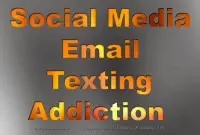Social Media, Email, Texting (SMET) Addiction
 A SMET addiction exists for three reasons. First, it’s extremely hard to resist engaging, and SMET has potentially harmful effects, the second reason. Finally, SMET provides opportunities for denying an addiction.
A SMET addiction exists for three reasons. First, it’s extremely hard to resist engaging, and SMET has potentially harmful effects, the second reason. Finally, SMET provides opportunities for denying an addiction.
Social media is hard to resist because we enjoy sharing our stories. It stimulates the same reward systems as sex, food and money do. Additionally, we get rushes from simply checking our social media, emails and texts. As “The Selfish Meme” (The Atlantic, October 2012 edition) explains:
Like playing a slot machine, engaging in these activities sends the animal brain into a frenzy as it anticipates a possible reward: often nothing, but sometimes a small prize, and occasionally an enormous jackpot.
SMET problems arrive as decreased efficiency, productivity, effectiveness and happiness. “Fix This Workplace” (Bloomberg Businessweek) and “Slaves to the Smartphone” (The Economist, March 10, 2012 edition) are representative of the increasing number of articles reporting emails decreasing our efficiency and productivity. The distractions they and all of SMET create reduce our effectiveness and creativity.
In regards to happiness, we are happiest when we interact with people in the same space. A correlation exists between happiness and number of in-person interactions. SMET reduces the reasons for meeting in that same space. Despite the dramatic increase in our interconnectivity with people around the world, loneliness has increased just as dramatically (“Is Facebook Making Us Lonely?”, The Atlantic, May 2012 edition).
This leads directly into the third reason SMET is an addiction. It deludes us into thinking we are connecting and interacting healthily thus providing plenty of opportunities for denial.
Solutions not only include transferring SMET time to in-person interactions, but also to more sidebar interactions with those online. It means sharing confidences and avoiding the superficial, Pollyannaish-speak indicative of social media. In other words, it means being human.


Great post Mike on a very important topic.
I recently shared with another friend in an email (grins) about the dilemma I have been feeling when it comes to connection versus GENUINELY connecting online via social media, etc.
On the one hand, I intentionally connect to network, share ideas, to ultimately feel part of the human race and not feel so isolated as I traverse through some career changes and adjustments I’ve had to face.
That said, I have personally felt that ‘gap’ in learning the difference between superficially connecting with people on line versus still feeling not quite ‘connected’. Thus, we can easily have an ILLUSION of connection because we may initially confuse CONTACT with connection.
In reality, connection is much deeper. For me it’s more like a head/heart connection with another human being that transcends superficial exchanges that may have other motives or intentions related to business or making a sale or promoting one self and services. It’s the kind that leads to a genuine interest in others BEYOND career and business motives.
Although the building of genuine connections tend to naturally lead to genuine business and word of mouth networking possibilities.
Online we can communicate with dozens or even hundreds of people a day and still feel ‘lonely’. And we can also connect with one or two and feel GENUINELY connected.
It’s the latter that I tend to look for while swimming through the former on a daily basis.
Lastly, I have found that it IS important to make time to intentionally disconnect. Info overload can truly wreak havoc on the senses and creates a ton of noise that is helpful to disconnect from.
I need to do it more often.
Thanks for this great post and for the good reminder.
As always, Samantha, thank for visiting and commenting. You’ve stated the solution whether you did it purposely or not. It’s similar to real life. Some connections are superficial some are not. The problem with SMET is the lack of personal contact that we can’t get via phone or in person.
My interpretation of what you’re saying is that there’s a difference between connecting and relating. As you and I have discussed before, there are public responses which tend to require a “happy” filter and private ones where we can discard that filter for a realer one or no filter. The problem is when we begin to believe that this “happy” world which I prefer to call Pollyannaism is real. So then our lives, when compared to Pollyannaism, not only seem less desirable but also detached, separate, isolated and finally, lonely. In a way, what we find on SMET is a less polished form of advertising. Imagine for a moment if we evaluated our lives based on the commercials we see on television? In many ways, I consider viewing our lives from a SMET perspective no different except the people doing the “advertising” aren’t as professional in most cases as the ones on television.
And, to complete the analogy, commercials on television are designed to make us dissatisfied in some way so we go out and purchase whatever it is they want us to purchase. So, it’s no wonder, if SMET is informal advertising that the same feelings and emotions are at work.
Anyway, you’re right. Feeling genuinely connected is key, and it does require work.
Thank you again, Samantha. ~Mike